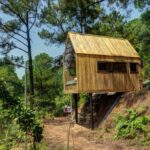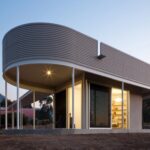Nov 21, 2013 • Japanese House
Small House Designed to Take Advantage of the Sun’s Path

This simple looking small house can be found in one of Tokyo’s high-density residential areas. The house was built on a small plot of land and has a total useable floor space of just 670 square feet (that includes the ground and first floor).

The house was designed by Japanese architecture firm, Case-Real, who were asked by the client for the southern end of the home to be filled with light. To address this requirement the architects introduced a hexagonal floor plan that allowed the sunlight to shine continuously into the living area from dawn to dusk. They achieved this by matching the window openings to the sun’s path across the sky.

Due to the small site, there was little of space available for car parking. So much so, that they clients were only able to accommodate a compact car. The small parking space is a trade-off of sorts between the house and the external circulation space. Obviously in this case the house was more important to the clients than having space for a large car (which is somewhat unnecessary within the dense city environment of Tokyo).

From the architect: “The site for this project was one of the 5 subdivided areas with the North side facing the street, and the other 3 sides neighboring the other houses. Within these difficult circumstances the client wished for a living room on the South side full of sun light. The core of this residential housing is the hexagon volume on the Southern side of the site. This shape resulted in a plan where sunlight continuously shines into the living room from dawn till dusk.
Creating a minimum parking space needed for a compact car and by sliding the volume of the structure to the North as far as possible, we were able to keep a planting ground and to efficiently let light into the room. For the plan of each floor and its traffic lines, the roof and the beam which can be seen at the ceiling of the 2nd floor, the existence of this hexagon structure works as a strong element to categorize the function, structure and design of the entire house.”

While the interior of the home isn’t currently furnished, the floor plans reveal how the spaces come together to serve the needs of the occupants. The southern end of the house has the largest living areas, with the mechanical areas (such as the kitchen and bathroom) being found towards the center of the building. Given the amount of space available, relatively little has been allocated to the kitchen. It seems rather unusual when compared to western design, which usually place a lot of emphasis (and hence space) on the kitchen.

For more Japanese houses check out this house from Nada by Fujiwarramuro Architetects that features a light well in the center of the home. Or the Near House in Tokyo, which lies within arms reach of other houses. See all Japanese houses.
Via ArchDaily
Photos: Takumi Ota
Join Our Newsletter And
Get 20% Off Plans
Get the latest tiny house news, exclusive
offers and discounts straight to your inbox



